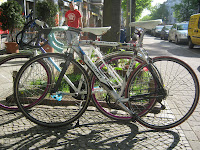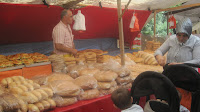 1. Spielplätze. Every afternoon playgrounds across Berlin are filled to the brim with children and parents (mums and lots of dads). This is not only is this because the playgrounds are amazing - pirate ship climbing frames, trampolines and zip wires - but because since everyone lives in flats, these are people's gardens. And their communal nature is no bad thing for creating a proper neighbourhood atmosphere (well, in Friedrichshain at least) that many people elsewhere romanticise about where kids play together and neighbourhoods stop and chat.
1. Spielplätze. Every afternoon playgrounds across Berlin are filled to the brim with children and parents (mums and lots of dads). This is not only is this because the playgrounds are amazing - pirate ship climbing frames, trampolines and zip wires - but because since everyone lives in flats, these are people's gardens. And their communal nature is no bad thing for creating a proper neighbourhood atmosphere (well, in Friedrichshain at least) that many people elsewhere romanticise about where kids play together and neighbourhoods stop and chat.
2. Those weird pink tubes. According to the Pollems website, these tubes that wind across move groundwater around and away from buildings.
 3. Spätis. Not only do these off-licenses have a pretty huge selection of beer and soft drinks (including about 7 types of coke, no monopoly here Coca Cola), they can double up as a cheap bar in the summer if you don't mind sitting outside on their benches and tables. Where else can you get a round for 70 cents per person? Perfect place to unwind when you get your Feierabend at 3am.
3. Spätis. Not only do these off-licenses have a pretty huge selection of beer and soft drinks (including about 7 types of coke, no monopoly here Coca Cola), they can double up as a cheap bar in the summer if you don't mind sitting outside on their benches and tables. Where else can you get a round for 70 cents per person? Perfect place to unwind when you get your Feierabend at 3am.
 4. Ice cream. I remember spending all my pocket money on ice creams during a German school trip 15 years ago, and the love of ice cream has not diminished here. All summer long (and even now into autumn) there are huge queues outside ice cream parlours. Everyone says the one in Falkensteinstraße is the best, but my fave is Eispiraten on Grünberger Straße. Two scoops for a euro!
4. Ice cream. I remember spending all my pocket money on ice creams during a German school trip 15 years ago, and the love of ice cream has not diminished here. All summer long (and even now into autumn) there are huge queues outside ice cream parlours. Everyone says the one in Falkensteinstraße is the best, but my fave is Eispiraten on Grünberger Straße. Two scoops for a euro!5. Broken and empty bottles. You have to watch you put your feet/ride your bike on Saturday and Sunday mornings to avoid the broken beer bottles that pretty much litter the streets. The homeless bottle collectors do a good job at weekends, and council street cleaners in the week (as my four year old brother put it 'they've cleaned up the party'), but they never get it all.
6. Pong. They love a bit of table tennis here, and have a couple of tables in every decent neighbourhood park or square. Good thing about it is you can play even if you're complete crap - but just watch out for the regulars who might challenge you to a game only to scare you off. Man in white cap in Travelplatz did this to us.
 7. Rain. This summer has been a bit of a washout at times. But while there has been some drizzle, mostly when the rain comes, it pours. Which means you are often cycling along at 100 miles an hour, looking over your shoulder, and trying to make it home before the big, black thundercloud unleashes its shower over you. If you do, you can enjoy thunder, lightning and then double rainbows from the dry. If not, drowned rat sums you up.
7. Rain. This summer has been a bit of a washout at times. But while there has been some drizzle, mostly when the rain comes, it pours. Which means you are often cycling along at 100 miles an hour, looking over your shoulder, and trying to make it home before the big, black thundercloud unleashes its shower over you. If you do, you can enjoy thunder, lightning and then double rainbows from the dry. If not, drowned rat sums you up.
 8. Swimming in the lake. There are tons of great lakes around Berlin that you can have a dip in. The bottom is a bit sludgy and squelchy in some, but once you get over it, they are great. You can choose tiny patches of bankside that are more secluded like Schlachtensee or the pine forested north bank of Müggelsee (you might have to walk round a bit to find a spot), nudist sections (FKK) of the main beaches if that's your thing, or the Badeschiff if you prefer a trendy-infused swimming pool over lake water. But for a lovely, open, sandy bottomed beach - its got to be Strandbad Wannsee.
8. Swimming in the lake. There are tons of great lakes around Berlin that you can have a dip in. The bottom is a bit sludgy and squelchy in some, but once you get over it, they are great. You can choose tiny patches of bankside that are more secluded like Schlachtensee or the pine forested north bank of Müggelsee (you might have to walk round a bit to find a spot), nudist sections (FKK) of the main beaches if that's your thing, or the Badeschiff if you prefer a trendy-infused swimming pool over lake water. But for a lovely, open, sandy bottomed beach - its got to be Strandbad Wannsee. 9. Leisure time more generally. Maybe its because I'm not working full-time here, but I do get the impression that Berliners take their free time more seriously than Brits. Everyone wishes you a 'Schönen Feierabend' (literally celebration evening, or happy end of work) and there is tons of organised (e.g. climbing and parcour clubs), semi-organised (e.g. 32 urban beach bars, grill-boats to rent, flea-market kareoke and u-v crazy golf) and non-organised (picnics in the park) to do.
9. Leisure time more generally. Maybe its because I'm not working full-time here, but I do get the impression that Berliners take their free time more seriously than Brits. Everyone wishes you a 'Schönen Feierabend' (literally celebration evening, or happy end of work) and there is tons of organised (e.g. climbing and parcour clubs), semi-organised (e.g. 32 urban beach bars, grill-boats to rent, flea-market kareoke and u-v crazy golf) and non-organised (picnics in the park) to do. 10. Helping out during house moves. I've already blogged about how flats come with literally just the kitchen sink and you have to deck them out with washing machine, wire the electricity and paint the floors/ceilings/walls. Well the nice thing is that whenever people move here, they invite their friends to help them out and take them out for some lunch/drinks afterwards. Pretty essential if you're moving from the second to the fifth floor across town - and Joe and I are slowly banking up some points for when we need some help to move out of our flat next year.
10. Helping out during house moves. I've already blogged about how flats come with literally just the kitchen sink and you have to deck them out with washing machine, wire the electricity and paint the floors/ceilings/walls. Well the nice thing is that whenever people move here, they invite their friends to help them out and take them out for some lunch/drinks afterwards. Pretty essential if you're moving from the second to the fifth floor across town - and Joe and I are slowly banking up some points for when we need some help to move out of our flat next year.









































